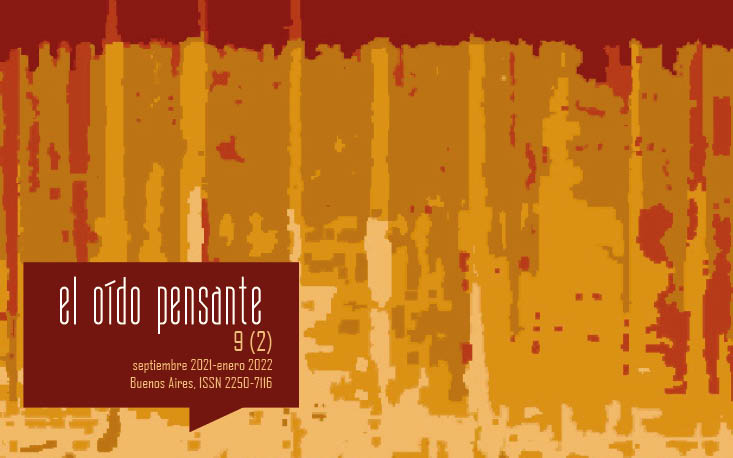The Other in the Sound of Music: Exploring Interactions in Jazz Improvisation from a Second Person Perspective
Abstract
Interaction between performers is important for jazz improvisation; musicians describe it as a kind of musical conversation (Monson, 1986). Interactive aspects that are particularly special in improvisation are analyzed from the Second Person Perspective (Pérez and Gomila, 2021). This theory addresses emotional involvement and direct attributions of intentionality in human interaction. Two groups of improvisers who played a standard together were interviewed. The content of the interviews was analyzed using qualitative analysis methods (Strauss and Corbin, 1998). The categories resulting from the analysis in dialogue with the constructs of the theory help us to understand how improvisers attribute intentions reciprocally during their doing. They show how musicians make their own the other’s ideas, their sound and corporality. Jazz improvisation is constructed in dialogue with the intention of the other, an intention that can be accompanied, reinforced, discussed, even not shared. The own intention takes shape in the encounter with the intention of the other in the music that sounds.Downloads
References
Berliner, P. (1994) Thinking in Jazz. The Infinite Art of Improvisation. Chicago: University of Chicago Press.
Español, S. (2010): Performances en la infancia: cuando el habla parece danza, música y poesía. Epistemus, nº 1, pp. 57-95. doi.org/10.21932/epistemus.1.2702.0
Gomila B. A., y Pérez, D. (2018). Mental Attribution in Interaction: How the Second Person Perspective dissolves the Problem of Other Minds. Daimon. Revista Internacional De Filosofia. 75. doi:10.6018/daimon/332611
Gomila, A. (2002). La perspectiva de segunda persona de la atribución mental. Azafea: Revista de Filosofía, 4, 123-138.
Gratier, M. (2008). Grounding in musical interaction: Evidence from jazz performances. Musicae Scientiae, 12(1, Suppl.), 71–110. doi:10.1177/1029864908012001041
Johnson, M. (2007). The meaning of the body. Aesthetics of human understanding. Chicago, Estados Unidos: The University of Chicago Press.
Leman, M. (2011). Cognición musical corporeizada y tecnología de la mediación (Traductores Martínez, I. C., Herrera, R., Silva, V., Mauleón, C. y D. Callejas Leiva). Buenos Aires: Sociedad Argentina para las Ciencias Cognitivas de la Música (2008).
Leman, M. (2016). The Expressive Moment. How Interaction (with Music) Shapes Human Empowerment. Massachusetts, Estados Unidos: The MIT Press.
Maloch, S. y Trevarthen, C. (Eds.) (2009) Communicative musicality: exploring the basis of human companionship, Oxford, Oxford University Press.
Martínez, I. C. (2008). Cognición enactiva y mente corporeizada: el componente imaginativo y metafórico de la audición musical. Estudios de Psicología, 29(1), 31-48. doi:10.1174/021093908783781419
Martínez, l. C. y Español, S. (2009): lmage-schemas in intuitive parental performance, en Louhivuori,J.; Eerola, T.; Saarikallio, S.; Humberg, T. y Eerola, P.-S. (eds.), Proceedings of the 'J'h Triennial Conference of ESCOM, Jyvaskyla, pp. 297-305.
Martínez, I. C. (2014). La base corporeizada del significado musical. In S. Español, Psicología de la música y del desarrollo. Una exploración interdisciplinaria sobre la musicalidad (pp. 71-110). Buenos Aires (Argentina): Paidós.
Martínez, I. C., Damesón, J., Pérez, J., Pereira Ghiena, A., Tanco, M. y Alimenti Bel, D. (2017). Participatory Sense Making in Jazz Performance: Agents’ Expressive Alignment. 25th Anniversary Conference of ESCOM: The expressive interaction with music. Gent: European Society for Cognitive Sciences of Music.
Monson, I. (1996) Saying Something: Jazz Improvisation and Interaction. Chicago: The University of Chicago Press.
Pérez, D. (2013). Sentir, desear, creer. Una aproximación filosófica a los conceptos psicológicos. Buenos Aires, Ed. Prometeo.
Pérez, D., y Gomila, A. (2021). Social cognition and the second person in human interaction. London: Routledge.
Pérez, D. y Lawler, D. (2017) La segunda persona y las emociones. Ed. SADAF. Buenos Aires.
Pérez, J.B. (2015) Interacción en la improvisación jazzística: El análisis de los aspectos rítmicos en el ciclo de percepción-acción. Percepta. 2(2) (95-110). Asociacion Brasileira de Cognição e Artes Musicais.
Pérez, J.B. (2016). Improvisar en Jazz: Un estudio psicomusicológico de la improvisación con músicos argentinos. [Tesis doctoral inédita]. Facultad de Artes, Universidad Nacional de La Plata. doi:10.35537/10915/52468
Pérez, J.B.; Tanco, M.; Martínez, I.C.; Alimenti Bel, D.; Dameson, J.; Pereira Ghiena A. (2017). La construcción del sentido participativo en la música: dinámicas de interacción ‘orientador-orientado’ en la improvisación jazzística. En N. Alessandroni y M.I. Burcet (Eds.), Actas del 13º Encuentro de Ciencias Cognitivas de la Música (pp. 350-360). Buenos Aires: SACCoM.
Pérez, J.B., y Martínez, I. C. (2020). Encontrarnos en la performance. Epistemus. Revista De Estudios En Música, Cognición Y Cultura, 8(2), 021. doi.org/10.24215/18530494e021
Reddy, V., y Morris, P. (2004). Participants Don't Need Theories: Knowing Minds in Engagement. Theory & Psychology, 14(5), 647–665. https://doi.org/10.1177/0959354304046177
Reddy, V. (2008). How Infants Know Minds. Cambridge, MA: Harvard University Press.
Sawyer, K.R. (2003). Group creativity: Music, theatre, collaboration. Mawah, NJ: Lawrence Erlbaum.
Schogler, B. (2002). The pulse of communication in improvised jazz duets. Tesis Doctoral no publicada, The University of Edinburgh, U.K.
Scotto, C. (2002). Interacción y atribución mental: la perspectiva de la segunda persona. Análisis filosófico, 22(2), 135-151.
Strauss, A. L., & Corbin, J. (1998). Basics of qualitative research: Techniques and procedures for developing grounded theory (2nd ed.). Thousand Oaks, CA: SAGE.
Trevarthen, C. (1999). Musicality and the intrinsic motive pulse: Evidence from human psychobiology and infant communication. En Musicae Scientiae (Special Issue 1999–2000), 155–215.
Walton, A.; Washburn, A.; Langland-Hassan, P.; Chemero, A.; Kloos, H.; Richardson, M. (2017). Creating Time: Social Collaboration in Music Improvisation. Topics in Cognitive Science. doi:10-1111/tops.12306























